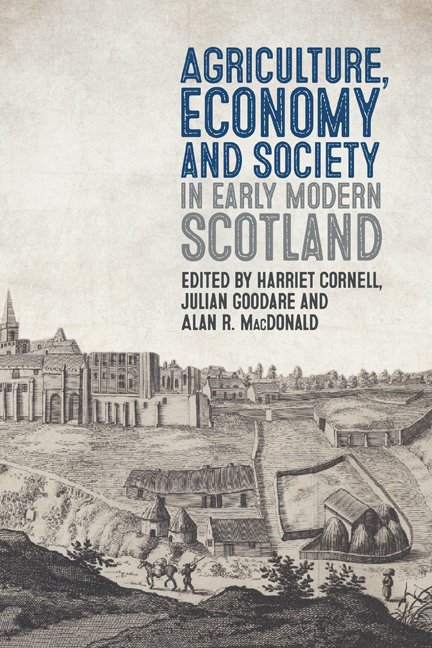Book contents
- Frontmatter
- Dedication
- Contents
- Illustrations
- Contributors
- Acknowledgements
- Note on Currency and Measures
- Abbreviations
- Map of Scotland
- Introduction: Exploring Scotland’s Agricultural History
- 1 Imagining Scottish Agriculture before the Improvers
- 2 The Use of Dykes in Scottish Farming 1500–1700
- 3 The Famine of 1622–23 in Scotland
- 4 Weather and Farming through the Eyes of a Sixteenth-Century Highland Peasant
- 5 Stock, Fermes, Mails and Duties in a Midlothian Barony 1587–89
- 6 The Roots of Improvement: Early Seventeenth-Century Agriculture on the Mains of Dundas, Linlithgowshire
- 7 ‘God Knowis my Sleipis ar Short and Unsound’: Andro Smyth’s Collection of Rent, Tax, Teind and Tolls in Shetland c.1640
- 8 Farming in the Stirling Area 1560–1750
- 9 What Were the Fiars Prices Used For?
- 10 Agriculture and Banking in Eighteenth-Century Scotland 1695–1750
- 11 Capitalism’s Cradle? Ideas, Policies and the Rise of the Scottish Economy in the Mercantilist Age 1600–1800
- Conclusion: A Historiographical and Bibliographical Overview
- Index
- Boydell Studies in Rural History
5 - Stock, Fermes, Mails and Duties in a Midlothian Barony 1587–89
Published online by Cambridge University Press: 14 May 2024
- Frontmatter
- Dedication
- Contents
- Illustrations
- Contributors
- Acknowledgements
- Note on Currency and Measures
- Abbreviations
- Map of Scotland
- Introduction: Exploring Scotland’s Agricultural History
- 1 Imagining Scottish Agriculture before the Improvers
- 2 The Use of Dykes in Scottish Farming 1500–1700
- 3 The Famine of 1622–23 in Scotland
- 4 Weather and Farming through the Eyes of a Sixteenth-Century Highland Peasant
- 5 Stock, Fermes, Mails and Duties in a Midlothian Barony 1587–89
- 6 The Roots of Improvement: Early Seventeenth-Century Agriculture on the Mains of Dundas, Linlithgowshire
- 7 ‘God Knowis my Sleipis ar Short and Unsound’: Andro Smyth’s Collection of Rent, Tax, Teind and Tolls in Shetland c.1640
- 8 Farming in the Stirling Area 1560–1750
- 9 What Were the Fiars Prices Used For?
- 10 Agriculture and Banking in Eighteenth-Century Scotland 1695–1750
- 11 Capitalism’s Cradle? Ideas, Policies and the Rise of the Scottish Economy in the Mercantilist Age 1600–1800
- Conclusion: A Historiographical and Bibliographical Overview
- Index
- Boydell Studies in Rural History
Summary
Sir James Forrester II, baron of Corstorphine, died intestate on 4 June 1589, killed in a brawl or ambush. On 12 August 1589 nine men were accused in the Justiciary Court of being accessories to his slaughter, but the case was adjourned. Mr Samuel Cockburn of Temple, though not named in the case, applied to the Dalkeith Presbytery on 15 March 1590 to be received as a penitent, ‘together with his servants that were participant of the Laird of Corstorphine's slaughter’. He later told them that he had received a royal pardon, and ‘the party was almost satisfied’ – probably a reference to compensating Sir James's heir. Forrester's estate of Clerkington was adjacent to Cockburn's barony of Temple, and although local issues may have been involved, it is more than likely that the main conflict between the two lairds was political. Forrester had helped Mary Queen of Scots escape from Lochleven Castle and fought for her at Langside, while Cockburn was a supporter of the king's party. Where and why the killing took place remains a mystery. Forrester's principal legacy to historians is not in the field of political history, however: it is the testament dative drawn up for the Edinburgh Commissary Court under the supervision of his sister Isobel, wife of James Baillie younger of Carfin, who was appointed his sole executrix.
The heir to Sir James's heritable estate – land, houses, and their appurtenances – was his younger brother Henry, since the deceased and his wife Jean Lauder had no surviving children. Heritable properties were not subject to testamentary disposition in Scotland, and the heir's share in the moveable goods – referred to as the ‘heirship’ – was also excluded from testaments. A testament dative was therefore a balance sheet of the deceased person's remaining assets and liabilities, including debts owing to and owed by them. Sir James's inventory includes an impressive array of household goods, plate, clothing and jewellery with a total value of £666 13s. 4d. (1,000 merks).
- Type
- Chapter
- Information
- Agriculture, Economy and Society in Early Modern Scotland , pp. 130 - 146Publisher: Boydell & BrewerPrint publication year: 2024



